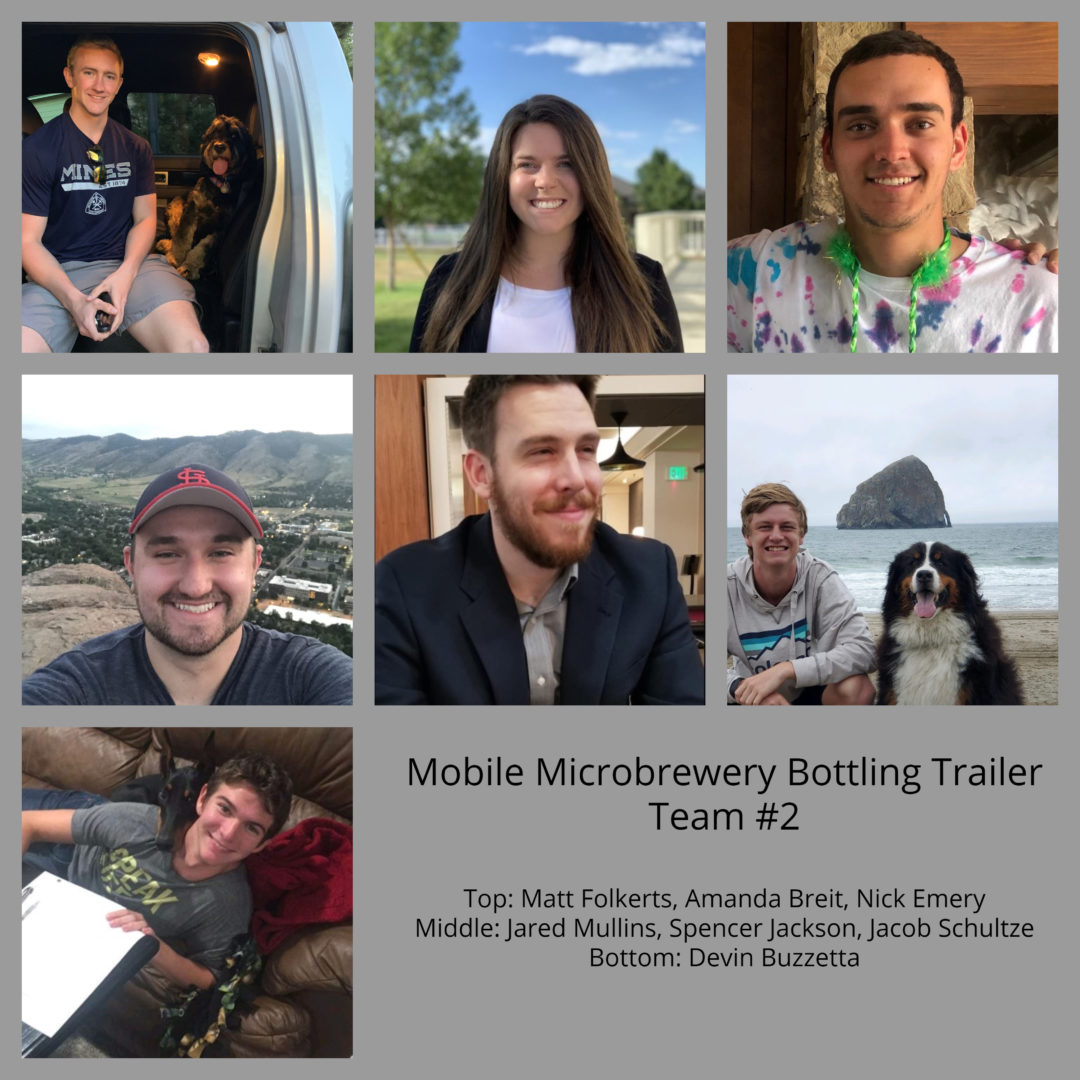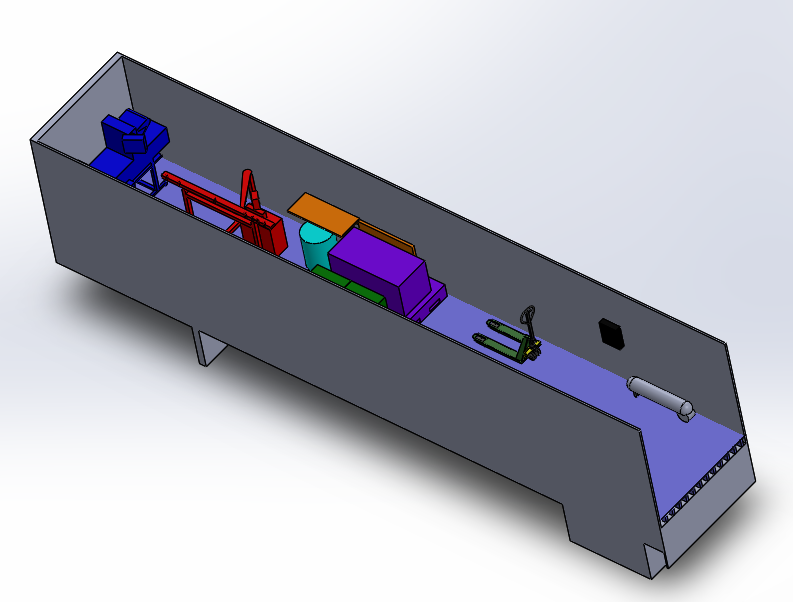Zoom Link:
Elevator Pitch:
Project Overview:
Colorado is one of the largest brewing states in the country. From factories such as Coors, to small scale breweries like Golden City Brewery, there’s a wide selection. Many of these smaller breweries do not have the resources or space to have their own bottling line, so they have to settle for hand bottling. They also lack the resources to package their product for outside distribution. Being able to sell their product elsewhere would elevate their status and recognition across the state, which is why it’s important to bottle and sell at other locations around the state.
Design Approach:
The team started off splitting an ideal trailer into multiple sections: temperature control, trailer and equipment selection, compliances with Federal organizations, sanitation, and generator requirements. These sections created tangible deliverables for our trailer to present to our client.
Stakeholder research with local breweries led the team to Wildgoose equipment for our bottling and labelling needs. The products are industry recommended and capable of bottle dimension diversity. As part of the federal compliance requirement, our client suggested implementing a false floor for spillage collection.
Through further research, development, and stakeholder interactions we were able to present a few layout options to our client with various customization requirements to advance the project. We chose our simplest design because it was the least costly and had the greatest ease of assembly. This places the machinery in line on the side of the trailer to create a U shaped material flow. Another idea was to use an HVAC system from a bus or RV due to their similar size to a trailer.

| Team Suds | Conveyor design | Simple design | Rails design | ||||
| Selection Criteria | Weight | Rating | Weighted Score | Rating | Weighted Score | Rating | Weighted Score |
| Custom manufacturing | 10% | 1 | 0.1 | 5 | 0.5 | 3 | 0.3 |
| Ease of assembly | 25% | 2 | 0.5 | 5 | 1.25 | 4 | 1 |
| Safety/break points | 20% | 5 | 1 | 5 | 1 | 5 | 1 |
| Cost | 20% | 1 | 0.2 | 5 | 1 | 3 | 0.6 |
| Rate of product flow | 15% | 5 | 0.75 | 5 | 0.75 | 3 | 0.45 |
| Ease of Use | 10% | 4 | 0.4 | 4 | 0.4 | 3 | 0.3 |
| 100% | Total Score | 2.95 | Total Score | 4.9 | Total Score | 3.65 | |
| Rank | 3 | Rank | 1 | Rank | 2 | ||
We developed relative CAD models to help visualize our trailer. This led us to moving the filler/capper to the back wall near the hitch. Our new design saves valuable space for other storage requirements. It also allows us to reduce the heated zone, which we control with a check curtain. In addition to this, our design utilizes a false floor design to ensure less slipping from spillage, and contributes to the air flow through the trailer. The electrical side of the trailer was calculated using the datasheets from each machine/component that needed electricity. An electrical load analysis was calculated to ensure the generator could power the trailer. The team presented a process flow simulation that allowed us to see how fast the operation could be completed by an operator, who is the licensed CDL driver of the trailer. At this point we had also begun risk mitigation strategies to improve our trailer design. The largest identifiable risks were it being a one man operation and any damage to occur during transportation. These risks were the most likely to stop production and our solution was to add a second operator and secure the equipment to the walls and floors.

Further FlexSim analysis proved that a second operator would be highly beneficial to our solution. While reviewing the economics calculations, the team realized the overestimation of the yearly salary of the licensed CDL could also accommodate a second worker in that budget.
Design Solution:
From the design considerations, we recognized that our trailer would have to be in compliance with many federal, state and local regulations. In order to also ensure that the trailer was running as efficiently as possible, we ran many simulations and spoke to stakeholders and manufacturers that could present more options and information. Our design solution is a 45-ft trailer equipped with a full electrical system, HVAC, bottling line, false floor, and many miscellaneous items that would help to operate the trailer as efficiently and safely as possible.
The electrical system utilizes a generator to transpose energy to lighting, machinery, and heating / cooling systems. An electrical load analysis was performed to ensure that the generator would provide enough power to run safely and consistently. HVAC is performed with insulation and a check curtain. HVAC analysis was also performed using heat transfer calculations, ensuring that the air flow through the trailer would be allowable. This was also accomplished through the use of a false floor design. The false floor is 6 ½ inches at its tallest point and utilizes a ⅛ inch drop per foot towards the drainage system to ensure proper drainage.
The design solution also encompasses many safety considerations. Through analysis of the risks associated with this business, our team made decisions to hire a second worker to run operations with the brewmaster, as well as create the false floor design to mitigate risks with slipping. In order to be extra safe, there are three emergency shut offs for the electrical system. There are two of them inside and one outside the trailer which allow for easy access in case of an emergency.
Next Steps:
The main purpose of the project was completed by the team. It is in no way perfect, but it is a viable solution according to our economic calculations and all deliverables being met. The project could be expanded upon in economics to ensure the quality before being presented to an investor. Along with this, the HVAC was proven viable through equations, so a simulation could be run using HVAC software to produce visual results to present to potential investors and employees. Another deliverable would be more advanced FlexSim analysis to the full capacity of the trailer because our design reduced speed of machines in favor of less rigorous movement for the operators. Once these tasks are completed, the trailer could be built and put through physical testing in order to see what components work as expected/simulated and what needs to be reworked.



